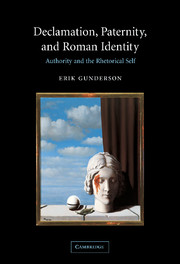Book contents
- Frontmatter
- Contents
- Preface: Acheron
- Introduction: A praise of folly
- PART I WHERE EGO WAS …
- 1 Recalling declamation
- 2 Fathers and sons; bodies and pieces
- 3 Living declamation
- 4 Raving among the insane
- PART II LET ID BE
- By way of conclusion
- Appendix 1 Further reading
- Appendix 2 Sample declamations
- List of references
- Index locorum
- General index
2 - Fathers and sons; bodies and pieces
Published online by Cambridge University Press: 10 December 2009
- Frontmatter
- Contents
- Preface: Acheron
- Introduction: A praise of folly
- PART I WHERE EGO WAS …
- 1 Recalling declamation
- 2 Fathers and sons; bodies and pieces
- 3 Living declamation
- 4 Raving among the insane
- PART II LET ID BE
- By way of conclusion
- Appendix 1 Further reading
- Appendix 2 Sample declamations
- List of references
- Index locorum
- General index
Summary
Mutilation and debilitation: these are vital declamatory themes. By vital I mean not only that there are numerous declamatory cases where bodily trauma plays a significant role, but the question of bodily integrity also occupies a significant position on the theoretical plane. The theory of declamation is itself informed by a thematic investment in a conception of soundness; and this soundness is a metaphor whose primary reference is to the body. Moreover, sound bodies are posited as the product of the proper relationship between father and son. Thus a good student of oratory knows both how to look after his own body and how to ensure that his relationship to his rhetorical sire is a healthy one.
The scenography of rhetoric and rhetorical training thereby becomes a venue for the satisfactory playing out of a “family romance” whose dénouement involves recognizing the salutary quality of the maxim that father knows best. Furthermore rhetoric becomes the ideal tool with which to cure an ailing father and to lend linguistic authority to a languishing paternal authority. Rhetoric, which itself derives so much of its own authority from the idea of the father, thereby ever plays the good son by offering back this patrimony of linguistic authority to a maimed father who no longer seems in possession of his full faculties. Within this context, subversion takes a special form: we see a promise of revolution and of freedom in the prospect of “out-fathering” the father and assuming his role when he can no longer live up to his own authority.
- Type
- Chapter
- Information
- Declamation, Paternity, and Roman IdentityAuthority and the Rhetorical Self, pp. 59 - 89Publisher: Cambridge University PressPrint publication year: 2003



